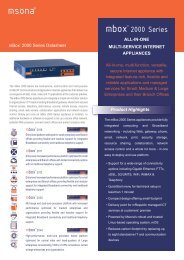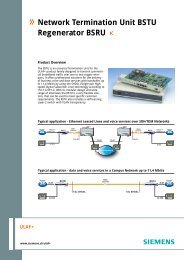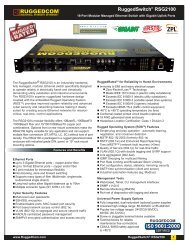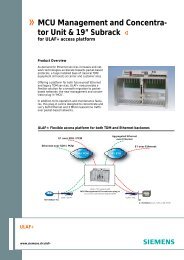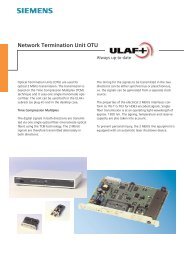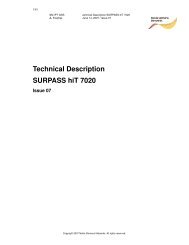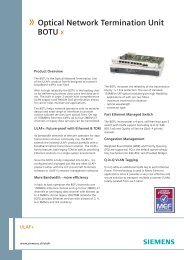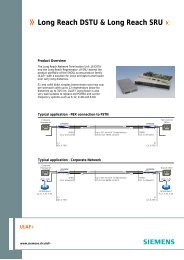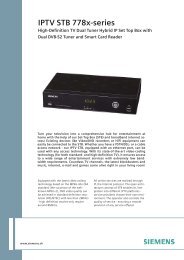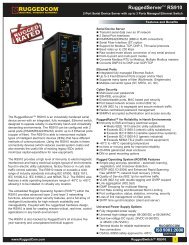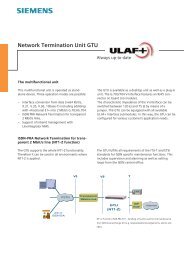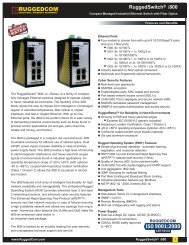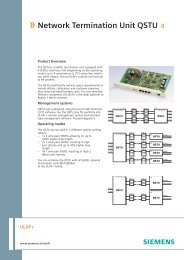RS1600 Family Datasheet Rev_X:RS1600 Family Datasheet Rev_P ...
RS1600 Family Datasheet Rev_X:RS1600 Family Datasheet Rev_P ...
RS1600 Family Datasheet Rev_X:RS1600 Family Datasheet Rev_P ...
Create successful ePaper yourself
Turn your PDF publications into a flip-book with our unique Google optimized e-Paper software.
RuggedSwitch ® <strong>RS1600</strong><br />
16-Port Managed Fiber Optical Ethernet Switches<br />
ROS TM Features<br />
Cyber Security<br />
Cyber security is an urgent issue in many industries where<br />
advanced automation and communications networks play<br />
a crucial role in mission critical applications and where high<br />
reliability is of paramount importance. Key ROS features that<br />
address security issues at the local area network level include:<br />
.Passwords - Multi-level user passwords secures switch<br />
against unauthorized configuration<br />
.SSH / SSL - Extends capability of password protection<br />
to add encryption of passwords and data as they cross<br />
the network<br />
.Enable / Disable Ports - Capability to disable ports so that<br />
traffic can not pass<br />
.802.1Q VLAN - Provides the ability to logically segregate<br />
traffic between predefined ports on switches<br />
.MAC Based Port Security - The ability to secure ports on<br />
a switch so only specific Devices / MAC addresses can<br />
communicate via that port<br />
.802.1x Port Based Network Access Control - The ability<br />
to lock down ports on a switch so that only authorized<br />
clients can communicate via this port<br />
.RADIUS - Provides centralized password management<br />
.SNMPv3 - encrypted authentication and access security<br />
The ROS cyber security features are included to help<br />
address the various industry specific security standards such<br />
as NERC CIP, ISA S99, AGA 12, IEC 62443, ISO 17799:2005<br />
and PCSRF SPP-ICS.<br />
Enhanced Rapid Spanning Tree Protocol (eRSTP)<br />
RuggedCom eRSTP allows the creation of fault-tolerant<br />
ring and mesh Ethernet networks that incorporate redundant<br />
links that are 'pruned' to prevent loops. eRSTP yields<br />
worst-case fault recovery 1 of 5ms times the 'bridge diameter'<br />
and allows rings of up to 160 switches. For example, a ring of<br />
ten switches will have fault recovery times under 50ms.<br />
eRSTP implements both STP and RSTP to ensure<br />
interoperability with commercial switches unlike other<br />
proprietary 'ring' solutions.<br />
Quality of Service (IEEE 802.1p)<br />
Some networking applications such as real-time control<br />
or VoIP (voice over IP) require predictable arrival times for<br />
Ethernet frames. Switches can introduce latency in times<br />
of heavy network traffic due to the internal queues that buffer<br />
frames and then transmit on a first come first serve basis.<br />
ROS supports 'Class of Service' in accordance with IEEE<br />
802.1p that allows time critical traffic to jump ahead to the<br />
front of the queue thus minimizing latency and reducing jitter<br />
to allow such demanding applications to operate correctly.<br />
ROS allows priority classification by port, tags, MAC<br />
address, and IP type of service (ToS).<br />
A configurable "weighted fair queuing" algorithm<br />
controls how frames are emptied from the<br />
queues.<br />
VLAN (IEEE 802.1Q)<br />
Virtual local area networks (VLAN) allow the segregation<br />
of a physical network into separate logical networks with<br />
independent broadcast domains. A measure of security is<br />
provided since hosts can only access other hosts on the<br />
same VLAN and traffic storms are isolated. ROS supports<br />
802.1Q tagged Ethernet frames and VLAN trunks. Port<br />
based classification allows legacy devices to be assigned<br />
to the correct VLAN. GVRP support is also provided to<br />
simplify the configuration of the switches on the VLAN.<br />
IGMP Snooping<br />
ROS uses IGMP snooping (Internet Group Management<br />
Protocol v1&v2) to intelligently forward or filter multicast traffic<br />
streams (e.g. MPEG video) to or from hosts on the network.<br />
This reduces the load on network trunks and prevents<br />
packets from being received on hosts that are not involved.<br />
ROS has a very powerful implementation of<br />
IGMP snooping that:<br />
.Can be enabled on a per VLAN basis.<br />
.Detects and filters all multicast streams regardless of<br />
whether subscribers exist.<br />
.Supports "router-less" operation by supporting an<br />
"active" mode.<br />
.Restores traffic streams immediately after an RSTP<br />
topology change.<br />
SNMP (Simple Network Management Protocol)<br />
SNMP provides a standardized method for network<br />
management stations the ability to interrogate devices from<br />
different vendors. SNMP versions supported by ROS are<br />
v1, v2c, and v3. SNMPv3 in particular provides security<br />
features (such as authentication, privacy, and access control)<br />
not present in earlier SNMP versions. ROS also supports<br />
numerous standard MIBs (Management Information Base)<br />
allowing for easy integration with any network management<br />
system (NMS).<br />
1 eRSTP fault recovery times may be approximated as follows:<br />
For 100 Mbps, fault recovery performance is



